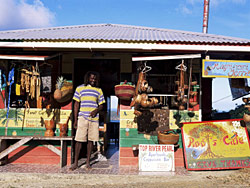| |
By Mark Rogers
Most visitors to Tobago will have one of two things on their mind; hitting the beaches and dive sites of the island, or roaming the unspoiled countryside seeking a glimpse of the island’s 200 species of birds. If your clients are going to be on the island for more than a few days, let them know about Tobago’s cultural and historical attractions. They’ll appreciate the option to implement a change-of-pace if need be, and move beyond the B&B (beaches & birds) Tobago experience.
The easiest way to tour the island is to hire a driver for the day. You can rent a car, but you may find yourself at least temporarily lost, since the road signs are spotty.
Scarborough is the capital of Tobago and the site of the island’s cruise ship port, which also makes it the island’s center for shopping. Try to time your visit on a Friday or Saturday morning – that’s when the Scarborough market is at its peak. Take some time to browse the colorful indoor and outdoor stalls selling all kinds of produce and goods. Chances are you’ll strike up a conversation with a local Tobagonian.
The historic centerpiece of the island is Ft. King George, perched on a cliff offering beautiful views of the bay. A tour of the fort can easily be paired with a visit to Scarborough, since the fort is a quick drive up the hill from the capital. The fort was built in the 1770s and was a focal point of defense for the island until 1854. Take some time to roam the grounds and peek in at the officer’s mess, prison and cannons aimed out over the bay. The barrack guardhouse has been transformed into the compact Tobago Museum, where you can view exhibits and historic artifacts chronicling Tobago’s history. Much of it centers on the military aspect of the island’s heritage, but there are also Amerindian artifacts on display. At the base of Ft. King George is the Fine Arts Centre, where local artists exhibit their work. Touring the fort is free, while the museum charges a modest entry fee of TT$5 (about 75 cents U.S.).
If you travel 15 miles east of Scarborough along the Windward Road, you’ll come to the Argyle Waterfalls, which at 175 feet are the most impressive falls on the island. At the entrance and parking area to the falls, you’ll most likely find guides waiting for customers. An admission fee of TT$30 (about $4.50 U.S.) includes the cost of the guide. It’s about a 15 minute walk along a path to get to the falls so it’s a good idea to wear comfortable shoes, as you may have to scramble over a few rocky bits. Once you get to the series of cascades you can take a dip in one of the pools, which at their deepest are 5 ½ feet deep.
The next suggestion is definitely off the beaten path. The Kimme Sculpture Museum is in Mt. Irvine, west of Scarborough on the leeward coast. The museum is a labor of love featuring the artwork of Luise Kimme, who is also the curator of the museum. The German-born artist grew to love Tobago to such an extent that she settled on the island in 1979 and began to create sculptures and paintings expressing her enthusiasm for the people of Tobago. Many of Kimme’s sculptures are created from whole tree trunks and can tower 12 feet over the viewer. Locals refer to the eye-catching architecture of the museum, which sports Teutonic turrets, as “The Castle.” The museum is only open on Sundays, from 10am to 2pm, but you can call and make an appointment to visit on other days of the week (868-639-0257). Admission is TT$20 (about $3 U.S.).

The fishing town of Speyside is on the windward side of the island’s far end. Most visitors go to Speyside for the glass bottom boat tours to Little Tobago Island, but the town has other charms as well. Jemma’s Tree House is a popular restaurant that is actually built up and around the branches of a huge tree. Order up some Creole cooking and relax. Service can be on the slow side so sip a drink and take in the surrounding sea views - you’re on island time. For a bit of history, seek out the Speyside Waterwheel, which was used to grind sugar cane. The wheel dates back to the 18th century, when sugar was king on the island.
The island’s biggest annual festival is the Tobago Heritage Festival. This year it will be held July 16 - August 1. For a look at some of the festivities reenacting an old time wedding, click HERE. |